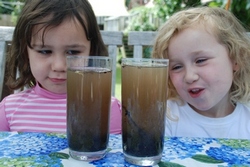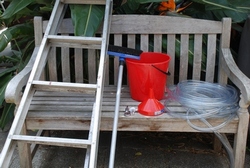 Cleaning your water tank should generally be limited to removing sediments, leaf litter or other matter such as insects and animals that may have accumulated in the tank.
Cleaning your water tank should generally be limited to removing sediments, leaf litter or other matter such as insects and animals that may have accumulated in the tank.
Any sediment residue should be pushed to the bottom of the tank and sucked out with a vacuum system or pump.
Siphoning off of sediments may also be done using an inverted funnel or pool vacuum cleaner, by dragging it along the bottom of the tank.
Instructions on how to siphon your water tank
Before refilling your tank, scrubbing it out with a super-chlorinated solution results in a more thorough clean.
A 1:2 dilution with water is advised (half a bucket of a plain, (unscented and uncoloured) household chlorine bleach (not Janola) in a full bucket of water).
Caution: Chlorine bleach can be corrosive to skin and eyes, even when diluted. Wear safety glasses and gloves for your own protection.
Warning: If you need to get into the tank to clean it, make sure there is adequate ventilation, and you have another person present at all times.
Warning: Take extreme care when cleaning your roof and gutters. Make sure the ladder is secure away from power lines, and have another person present at all times.
- Check that your roof, spouting and downpipes are free of dust, leaf litter and animal droppings.
- If you need to clean your roof, disconnect the pipes feeding the water tank first.
- Then remove the accumulated debris, using a chlorine solution (half teaspoon of household bleach (not Janola) with 10 litres of water) to scrub and flush away any faecal material.
- Cut back any overhanging branches, as these can increase the amount of bird droppings on your roof.
 It is best to clean your tank before refilling it.
It is best to clean your tank before refilling it.
Cleaning is easiest and the least wasteful when the water level is already low. And adding town supply water to a dirty tank is likely to cause odours, unpleasant tastes, and floating debris in the new water.
This is because the sludge and debris in the bottom of the tank gets disturbed when the tank is refilled. It then mixes with the chlorine in the delivered water and causes unpleasant changes to your drinking water.
If you do refill the tank without cleaning it, any debris should settle back down, and the chlorine will evaporate in a few days.
In the meantime, boiling your drinking water will help to improve the taste make the water safe to drink.
Water filters and other treatment devices help to prevent contamination of your household water.
- Filters can remove unpleasant tastes and odours, eliminate harmful germs, and remove some chemicals that may be present in your water.
- Note: Most filters will only do one or 2 of these jobs effectively - make sure you select the filter most appropriate for your needs.
There are many other types of treatment options beside filters, each with certain benefits. Ask about the different options before you purchase a treatment system.
Information and pamphlets
Rain harvesting systems - safer solutions for rainwater collection